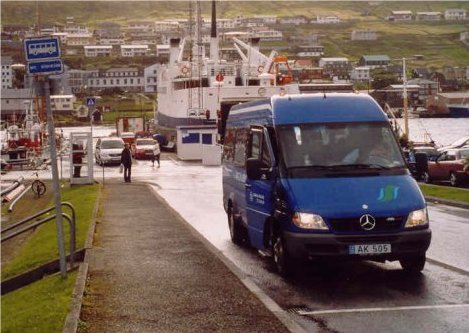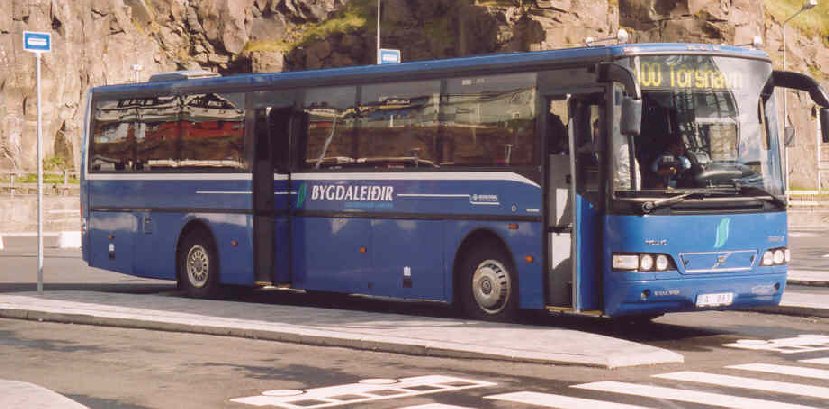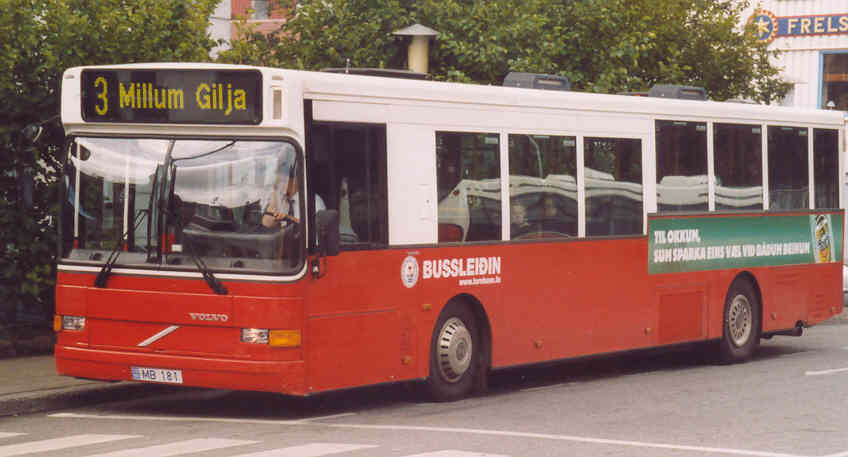ALL CHANGE The Faroe Islands revisited - an update from 2004 onwards
|
 |
|
This is a site of historical record and does not contain current service information Hendan sÝan vÝsur gamlar tÝarŠtlanir og ikki tŠr i eru galdandi n˙. Denne side viser gamle k°replaner og ikke de aktuelle tider. |
||
So once again I found myself in the Faroe Islands in August 2004. My third visit - it seems to be becoming a regular six-yearly event! Twenty nine passengers flew up from London Stansted with Atlantic Airways on a Thursday, and another twelve came on board at the intermediate stop at Aberdeen. The return flight on Sunday was direct to Stansted with fifty two travellers on board the 146. Privatisation is in the air (no pun intended) and Atlantic Airways, currently government owned, may be sold off and privatised. Inevitably there have been changes in the transport scene in Faroe since the last trip north in 1998. The road tunnel (opened 2002) linking the islands of Vagar and Streymoy has shortened the journey from airport to town considerably, and the ferry from Oyrargjˇjv to Vestmanna runs no more. This is the first toll tunnel in the islands, and a further tolled road tunnel is under construction from Leirvik to Klaksvik, due to open in summer 2006. This will bring the northern islands closer to the capital (and lead to the demise of another ferry service). What other changes did I find? Tˇrshavn now has bars and cafes selling beer and other alcoholic drinks, also several nightclubs now. Saturday night got quite noisy and rowdy but in a non-violent restrained sort of way. There's even a Burger King at the SMS shopping centre. And the city centre Post Office has moved next door to a new position, combined with the enquiry counter of the Tˇrshavn Kommuna local council offices. But it seems the Faroese postal service is operating at quite a deficit and there will be post office closures in the near future - postmark collectors be warned! Bygdaleiir |
||
| The rural
bus
(Bygdaleiir) and inter-island ferry services
(Oyggjaleiir) are secured by SSL
(Strandfaraskip
Landsins). Timetables are integrated to provide an efficient
transport network with through fares. The buses of
Bygdaleiir had gained a darker blue livery since my last visit
and are mainly new high floor Volvo coaches, dual doors, luggage
carried underneath. Some of the lesser routes are operated by
minibus, eg the 500 from Klaksvik to Viareii is
serviced by a 19-seater Mercedes (personalised registration AK505)
belonging to Askham Bussar. Thus we come to two more
significant changes. Personalised registration plates are now
available and many operators seemed to have taken advantage of
this. Also the Bygdaleiir bus network has reverted
once again to being completely provided by private operators contracted
to SSL - this had been the case until my 1998 visit when some of the
Tˇrshavn based routes were noted as being provided by buses
owned directly by SSL. The individual operators are listed by
route in the timetable book.
Some parts of the bus network are only operated on an as required basis. We walked across the hill five miles from Tˇrshavn to Kirkjubour one afternoon and were very pleased to see Jon Thomasen's Volvo/Carrus JT340 on route 101 later. Jon Thomasen, based in Kvivik, is a typical Bygdaleiir contractor and operates on the101 Kirkjubour and 300 Airport routes. We had phoned the control office before setting off on the walk and asked to be picked up. Figures showing the number of passengers carried on the buses in 2003 were obtained. Overall there had been some 573,000 passengers (compared to 641,000 in 2001). The individual route with the greatest number of journeys was the long route 400 from Tˇrshavn through K°llafjorur to Leirvik (for ferry Dugvan to Klaksvik) and Fuglafjorur. Interconnecting with a succession of other feeder services along the route, the 400 had carried 152,000 passengers in 2003 (up from 2001's 142,000). More typically the 200 feeder to Eii carried 20,000 in 2003 (2001 = 15,000) and the 101 to Kirkjubour and Gamlaraett (ferry to Sandoy) carried 24,000 (2001 = 26,000). The route with the lowest number of journeys for both years was the 205 feeder to Saksun with 80 passengers in 2003 and 109 in 2001. Given the difficult and sparsely populated operating territory it is not surprising that the bus and ferry network is heavily subsidised by the Faroese government.
|
 |
||||
|
A last thought on the trunk 400 route - it is now duplicated out from Tˇrshavn by Bussleiin route 4 buses as far as K°llafjorur - although the fare on the red buses is cheaper ............ and now free (2007)! A significant development in inter-island communications took place on 30th April 2006 when the new undersea road tunnel was opened linking Leirvik to Klaksvik. Bus route 400 was amended to operate through from Tˇrshavn to Klaksvik eleven times a day, with Fuglafj°rur served by new route 410 from thence to Klaksvik. The ferry from Leirvik to Klaksvik ceased on 7th May. |
|||||
|
|
|||||
Bussleiin |
||
| There had
been
changes too in the town bus network in the capital
Tˇrshavn. Previously operated by four different
contractors, each providing one or two buses, there were now only two
providers. The six buses needed for urban routes 1, 2 and 3
had since February 2003 been provided by Mouritsen
Bussar,
with a contract lasting until 2010. Mouritsen has
provided buses locally since 1983 and is sole survivor of the
previous four incumbent companies on the town routes. All of his
buses are low
floor easy access - or at least the front half of them is - and seem to
be about two to three years old. The suburban routes 4 and 5
to K°llafjorur
and Kaldbak are provided by Gunnurs Bussar of Signab°ur - one
vehicle observed on service 4 was an older red-liveried Volvo FD200
(not low floor).
The current Bussleiin routes (2004) are: 1 Hamarin - Steinatun - Gundadalur - Handilssk˙lin - Steinatun - SMS - Steinatun - Hamarin 2 Argir - Steinatun - Eystursk˙lin - Hvitanes - Inni ß G°tu - Steinatun - Argir 3 Norasta Horn - Steinatun - Millum Gilja - L°gmannabreyt - Eystursk˙lin - Steinatun - Norasta Horn 4 Farst°in - Signab°ur - K°llafjorur 5 Farst°in - Kaldbak and a typical day's run out for Mouritsen on routes 1, 2 and 3, observed on a Friday lunchtime in 2004 at Steinatun, was: MB255 Volvo - route 1 JL757 - Volvo - route 2 MB047 - Volvo - route 1 MB429 - Volvo - route 3 NV851 - Scania - route 2 MB 181 - Volvo - route 3 Typically town circular routes 1, 2 and 3 each operate half hourly Monday to Friday daytime and hourly in the evenings. Saturday and Sunday have an hourly daytime service, but no evening buses after 6pm. Route 4 has five journeys Monday to Friday and 5 has five journeys. On Saturdays and Sundays routes 4 and 5 are combined with three journeys whereas they are operated separately Monday to Friday. Both Bussleiin 4 and Bygdaleiir 400 go out to Kollafjordur. Since the 1998 visit services had been extended to the Hamarin district of Argir (route 1) and out to Kollafjordur (route 4). Generally though the town services didn't seem very busy except at school times. Drivers operate straight shifts of six or seven hours without breaks. There is an adult flat fare of 10 krone with tickets issued from Ultimate machines. Multi-journey tickets are also available, cancelled on each journey by the passenger in an electronic reader. In January 2007 the Tˇrshavn municipality introduced a free fares policy on the city buses. Originally meant as a trial, it was a success and was confirmed. From February 2008 the weekday daytime frequency on the main routes 1, 2 and 3 was increased from half hourly to every twenty minutes, requiring a further vehicle running to be introduced on each of those routes. No doubt the increase in frequency is a consequence of increased usage because of the free travel! However from August 2009 services were reduced by the withdrawal of Sunday services and also cessation of operations at 1400 hours on Saturday.
|
 |
|
|
|
||
|
||
 |
Click here to
return to the main index page |
 |
Click here
to return to the Faroes index page |
|


